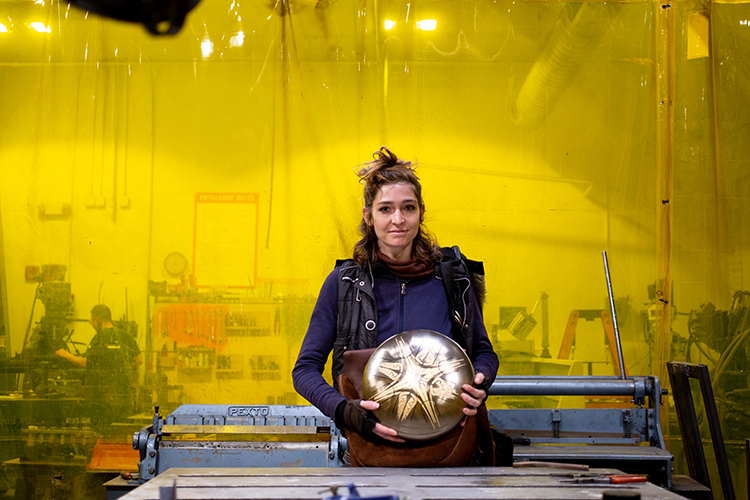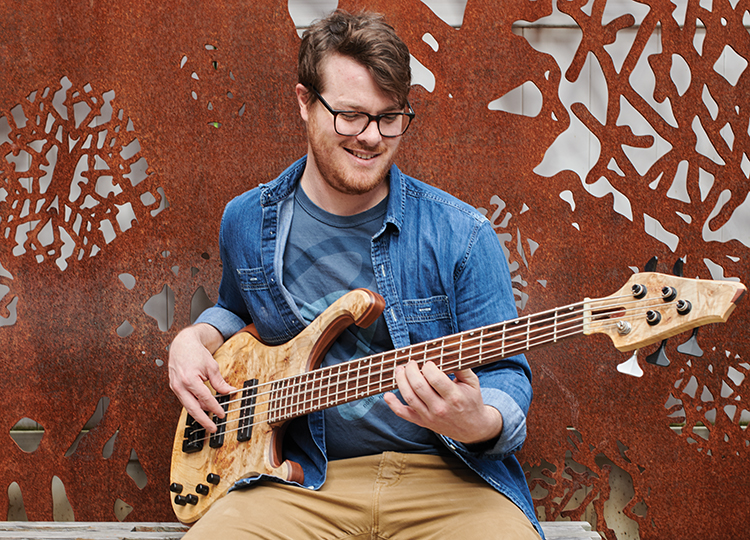Photo: Margo Reed
by Claire Marie Porter
(full story can be read here)
Michele Judge, a percussionist and jewelry-maker, began making her own drums after playing a friend’s steel tongue drum in southern Mexico. To her, the sound and feel of the instrument was intoxicating.
“I had to have one of these,” she says.
The steel tongue drum is a mix between two idiophonic instruments that are played on the lap: the handpan and Hang.
The Hang was invented in 2000 by two Swiss men as a meditative tool. The process for making the dome-shaped instrument was kept a mystery in order to avoid commercialism; to purchase one, an interested buyer had to write an essay to prove their worthiness, says Judge. It’s a large instrument, 52 centimeters in diameter and 24 high, and looks like a flying saucer.
The handpan is a relatively new instrument. It was created in 2007 by an American steelpan maker as an alternative and successor to the highly elusive Hang, and became popular quickly. While smaller than the Hang, it retains its swollen, domed shape.
Judge’s instrument, the steel tongue drum, is smaller yet, and was invented around the same time as the handpan by another steel drum maker, using the bottoms of 20-gallon propane tanks.
The idea of combining her artist’s eye and desire for a transportable meditative instrument led her to the seven-pound, saucer-shaped dome, with eight notes.
Judge partnered with a glass and leather artist, Carly Freedman, and together they founded Mayuca Drums. The company’s early models were made from old propane tanks, like the initial invention.
Now, 25 models later, Judge’s drums, made from sheets of mild steel, are so intricately beautiful that some customers buy them solely as decorations. The design is made with a white clay heat treatment process used in traditional Japanese swordsmithing, allowing for color variation. The designs and notes are mostly made with a water jet, a large machine that can cut through a foot of steel, which Judge has access to through her makerspace membership.
“It’s a meditative tool,” she says of the drum. “You’re focused on what you’re doing, but your mind is clear. Your hands get used to making the sounds … and the instrument becomes a voice.”
Judge plays one of her drums in the stairwell of NextFab. Her hands tenderly find a pattern on the symmetrical grid of the instrument, and the sounds grow, cocooning the space with long, drawn-out chimes. The tones are reflective.
The drum she plays on is tuned in A-minor pentatonic, her favorite key.
When Beethoven or Schubert composed in the key of A-flat, they considered it the “key of the grave.” It was common prior to the 20th century to associate different keys with certain emotions. A-minor is considered a very womanly key, invoking tenderness of character.
When Judge was first learning her craft, a drummer instructed her to play with her eyes closed.
“You can really feel and hear it when your eyes are closed,” she says.
Later, she grew more in sync with how her hands moved.
“Now it just takes you on this journey, and it can be emotional,” she says. “It’s the essence of who you are, coming through this instrument.”
Michele’s work can be found on her website







